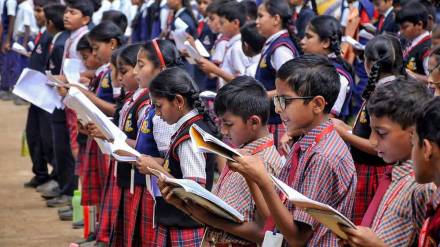Education in Chhattisgarh has come a long way. The state, like many other Indian states, faced challenges in providing quality education infrastructure and ensuring access to schools in remote and rural areas. However, it is worth noting that there has been significant progress in increasing the number of schools and issues related to teacher shortages. While more than 30,000 teachers were recruited in the last five years, the state government also has plans to spend around Rs 19,000 crore in the education sector.
Let’s take a look at the educational progress in the state in the last few decades.
Chhattisgarh literacy rate
The literacy rate in Chhattisgarh has shown a positive trajectory. According to the 2011 population census, Chhattisgarh had a literacy rate of 70.28 percent. This included a male literacy rate of 80.27 percent and a female literacy rate of 60.24 percent. The census reported a total of 15,379,922 literate individuals in Chhattisgarh, with 8,807,893 being males and 6,572,029 being females.
Pushing female education
Female education in many parts of India faces a protest from the age-old conservative mindset of the society which says that women are meant to stay at home. While today India has women shining in every sector, primary education still remains a dream for many young girls.
Chhattisgarh has not only struggled with this conservative mindset, but it also has had to deal with the added pressure of the naxal activities in the state. In 2004-05, the state launched the Saraswati Bicycle Scheme which aimed to promote the admission of girls in schools and cut down the dropout rate. Under this scheme, the girls from the SC/ST/BPL/Tribal groups studying in the 9th standard are provided with bicycles for free.
The state also focused on promoting higher education among girls and women and has established 26 women’s colleges. In the academic year 2018-19, around 1,34,391 female students enrolled in colleges. This figure was higher than the 91,982 male student enrollment recorded in the same year. In 2022–23, the number of male students increased to 1,28,310, whereas female students’ jumped to 2,06,829.
Nalanda Parisar, Raipur
Built over a six-acre campus, Chhattisgarh’s Nalanda Parisar in Raipur was set up by the state administration to help the youth looking for growth opportunities, preparing for competitive exams and empowering themselves. The Nalanda Parisar has an Oxy Reading Zone, along with a 24×7 community library. The library is open 24 hours a day and can accommodate up to a thousand students at a time. The Parisar offers complimentary Wi-Fi access, both indoor and outdoor reading areas, an electronic library, and a reprography section.
Educating the differently-abled
The Chhattisgarh administration has put in conscious efforts to alleviate the quality of education for differently-abled people. The government has established multiple schools and initiatives designed to meet the unique needs of differently abled students, with the goal of providing them with quality education and empowering them just like their peers.
The Saksham school, located within Education City in Dantewada, serves approximately 170 students under the guidance of specially trained teachers. The state also runs schools for differently-abled children in several districts, including Raipur, Jashpur, Bijapur and Kabirdham.
In 2017, Chhattisgarh received the National Award for the Best State in the Field of Disability.
